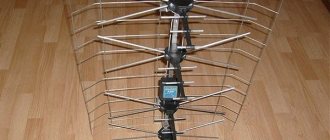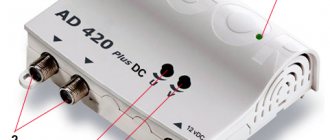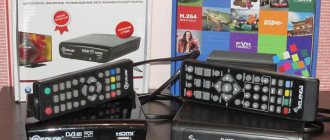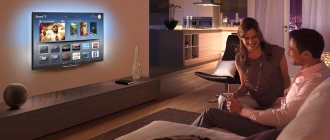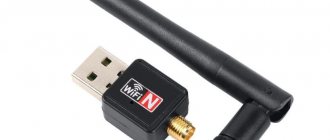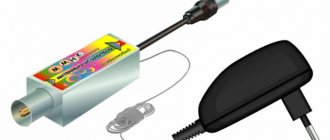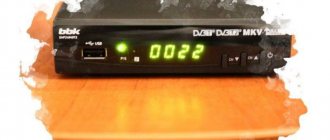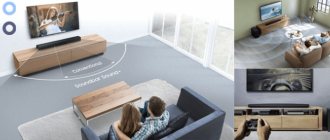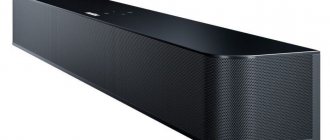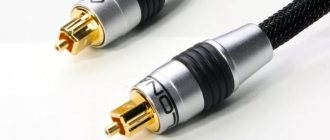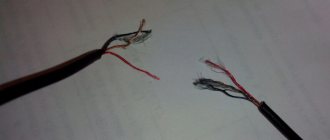| Place | Name | Characteristics in the rating |
| TOP 10 best amplifiers for antennas |
| 1 | Alcad AL-200 | High quality in all aspects of operation. The most popular amplifier in Russia |
| 2 | Eurosky SWA-105 | Highest gain (25 dB). Optimal price |
| 3 | Rexant 05-6202 | Wide range of amplified frequencies (5-2500 MHz). Three stream divider |
| 4 | World Vision EFIR4 | Best configuration |
| 5 | TERRA MA-025 | Possibility of separate adjustment of different ranges |
| 6 | REMO BAS-8233 | The most compact device with three outputs |
| 7 | Antex 30 | Best compact amplifier |
| 8 | TERRA HS 016 | The most secure device |
| 9 | Delta UTD-1101 | Best reliability indicator |
| 10 | REMO INDOOR-USB BAS-8102 | Compact amplifier with USB |
An antenna amplifier is one of the most important elements of a broadcast system, necessary to improve the quality of the signal when located at a significant distance from the broadcasting repeater or when communication with the satellite is unstable. It has a directed effect on changing the frequency of the wave received by the antenna with subsequent transmission to the appropriate equipment. In addition, these devices can perform the additional function of a splitter - dividing the signal into several streams to display the image on different TV screens.
The range of amplifiers on the market does not enjoy such high popularity from famous manufacturers, and, therefore, does not have a huge number of models sold. However, the whole problem with choosing a good device rests on basic ignorance of the main criteria, which is why purchases very often turn out to be in vain. Therefore, after carefully researching this segment, we have compiled for you a rating of the best amplifiers for digital and analog television, which are very popular among domestic users.
How to connect an antenna amplifier
The amplifying device consists of TV input connectors, TV output connectors and a power supply. When receiving energy from a TV cable or USB connector, there is no power supply in the circuit. To start the system:
- Connect the antenna cable to the amplifier input.
- Connect one or more televisions to the outputs of your amplification equipment.
- If necessary, insert the power plug into the outlet.
- If your device has a gain control, use it. To select the optimal settings, adjust them while watching TV.
Watch the video to see how to properly crimp new TV cables without special tools or outside help.
Methods for ensuring reliable TV signal reception
To ensure reliable signal reception, you need to find the reason for its loss. For this:
- To rule out a malfunction of the receiving equipment, try receiving a package of channels through another system, for example, a neighbor’s.
- Find the correct direction to the transmitter. To do this, turn the antenna and at the same time look at changes in the signal level on the TV - even old ones will show you the necessary data in scanning mode.
- Replace the nodes from the TV to the antenna one by one. Start with the cheapest and easiest to install.
In rare cases, the reflected signal is stronger than the direct one, for example, when a radio wave is reflected from an object that is located significantly above the receiving antenna, but is directed towards it.
When the reasons are clear, all that remains is to eliminate them:
- if an element of the receiving equipment is faulty, replace it;
- if the directional antenna is incorrectly directed, change its position;
- if the signal level from the transmitter is not enough, raise the receiving antenna array higher and install an amplifier.
An amplifier can amplify not only radio waves, but also ambient radio noise or interference.
Sometimes, to obtain a high-quality signal, it is enough to replace a cheap Polish antenna with a modern, efficient “delta”. An expensive passive antenna will probably receive much more useful signal under the same conditions. For a more detailed list of certified antennas suitable for receiving digital packets, see the link.
When will an antenna amplifier help?
An antenna amplifier will help if the channels are not shown, because the level of radiation from TV transmitters is consistently low at the location where the antenna is installed. This happens because:
- employees of the transmission center use a transmission device of insufficient power;
- there are obstacles in the path of the radio wave, and the level drops significantly;
- you are too far from any TV tower.
It is useless to boost a TV signal if you have not positioned the antenna correctly, are using faulty equipment, or are being interfered with by another transmitter. If there is interference, broadband amplification will not only not help, but will also worsen the electromagnetic background.
Advantages and disadvantages of antenna amplifiers
Lists the pros and cons of using amplifying television equipment in a table.
Advantages and disadvantages of TV amplifiers
| Advantages | Flaws |
| Improving the quality of received analog and digital channels | Multiple amplifiers can interfere with each other, distorting the resulting picture or sound |
| Reception even in remote areas and behind obstacles | Broadband amplification units increase the level of all radio waves. If any of these waves turns out to be too strong, the input stage will be overloaded and the receiver will temporarily fail. |
| Compact body | High price of individual models |
| Ability to customize the device as you use it |
Practical examples
Same type of antenna amplifiers for different distances and bandwidths
Receiving and amplifying a weak signal is a delicate matter. Therefore, a responsible manufacturer takes into account certain parameters of mating devices in its products with appropriate design solutions. If you buy an antenna and a separate amplifier for it yourself, you can get a problem with the appearance of the excitation effect and have trouble eliminating this phenomenon. Remote reception of a TV signal is a question that, for its optimal solution, requires a good knowledge of radio physics, as well as electronics.
Branded kit: power supply, antenna connector and antenna (shown in the image below)
Active antenna installed on the roof of a house
You should not purchase and install the equipment necessary for this without having good relevant knowledge and experience. It is also important to remember that for long-distance TV reception the antenna is located high above the ground. For this reason, she is at risk of being struck by lightning. Therefore, it is necessary to provide for its location in which the adjacent lightning rod creates a safe zone. But even in this case, with the onset of a thunderstorm, you must remove the antenna cable from the TV and the amplifier's power supply plug from the socket. Lightning can be unpredictable. Moreover, one single blow from it will damage not only the amplifier for the TV antenna, but also all the equipment connected to it.
Similar articles:
- What types of air conditioners are there and which one to choose for your apartment?
- How and by what parameters to choose a good TV?
- Wireless doorbells
Connecting to a TV
You can connect the antenna amplifier as follows:
- You need to install the amplifier as close to the TV as possible. This is true for branded devices and those made by hand. The exception would be room amplifiers that have short cables.
- Be sure to read the instructions before connecting. Often the nuances necessary for quality work are indicated there.
- If, after connecting the device, the picture quality leaves much to be desired, then perhaps the problem is in the integrity of the antenna or in the difference in frequencies.
- Connection should only be made with de-energized devices.
You can connect the device using the coaxial wire of a regular antenna. But for this, a special choke must be located along the power line. If the amplifier is powerful, then for high-quality operation it is connected through a capacitor element with low capacitance. Adjusting the device is easy. It is enough to move the resistor element to the middle and adjust it until the picture is of the highest quality.
How to boost the signal up to 20 channels with your own hands step by step
You can make an antenna signal amplifier yourself. It is a board or stationary device attached to a cable or antenna. The components for creating such a board are common. They can be purchased at any radio equipment store. But assembly will require at least basic knowledge of electronics and soldering of elements.
Here is one of the diagrams for assembling an amplifier for a TV antenna:
- Buy microcircuit max2633 (VT), R=1 kOhm, 1 nF capacitors.
- Additionally, a DC source with a voltage of 2.8 - 5.2 V is purchased.
- The assembly diagram is shown in the photo.
The finished product produces a noise level of about 2 dB and a gain of around 13 dB. This is not enough for the TV receiver to be located far away from the repeater. But it is enough to improve the signal within medium and large cities. The resulting device is suitable only for indoor antennas. And it is designed for a very short range with frequencies up to 900 MHz.
Broadband amplifiers are assembled according to the same principle, but using a different circuit. If control is required, internal controllers are additionally connected. Home electronics technicians can assemble complex devices themselves that match and even exceed the quality of store-bought equipment.
Advice. If you have never soldered microcircuits and did not understand small boards, it is better to buy ready-made equipment. The cost of an amplifier for a home antenna is low. And it doesn’t take much time to connect.
How to choose an amplifier
It is better to choose a strengthening technique based on your situation. Consider what antenna is installed, what channels you want to receive, and what kind of terrain surrounds you.
You can find out the frequencies to receive the channels you need on the Internet. They differ for different cities and regions.
By gain
Gain is a universal value measured in decibels (dB).
A decibel is a relative value that shows how many times the signal has changed. It is used to describe the characteristics of antenna arrays and amplifying devices. For example, a 3 dB difference in the levels of 2 signals means that one is 2 times more powerful than the other, 10 dB is 10 times more powerful, and 20 dB is 100 times more powerful.
If the distance to the nearest TV tower exceeds 30 km, do not be afraid to overdo it with the CG indicator - the more, the better.
If there are 15-30 km between the receiver and the television transmitter, the main thing is not to overdo it with the control panel. Too strong a signal will have the opposite effect and the channels will show better without an amplifier than with one.
At the installation location
As we wrote, there are 2 of them:
- On the roof, at the exit from the antenna. In this case, the signal level is first raised and then transmitted to you via wire. The result is better, but if you want to correct this process, you will have to go to the transmitter. Nothing compensates for losses in the cable.
- When coming out of the cable near the TV. In this case, the device amplifies what has already come to the TV. The process is easy to control and adjust, but the capabilities of the amplifier will be less than when used externally.
As a result, you will have to choose between increased quality and convenience.
Active or passive
Passive and active antenna arrays are used to receive radio waves. The latter are distinguished by a built-in amplifier, which is already matched in characteristics to the antenna.
If you are using an active reception system, then purchasing another amplifier will only be necessary for very difficult reception conditions, when there is not a single TV tower within a radius of 30 km or more.
If you decide to buy a separate amplifying device for an active antenna, keep in mind that the built-in and external amplifiers may interfere with each other. Buy devices with the most similar characteristics.
By frequency range
Decide what exactly you want to receive from the TV tower. There are several options:
- digital signal of the DVB-T2 standard with 2 multiplexes of 10-12 channels each;
- analog signal using decimeter waves;
- analog signal using meter waves.
Meter waves propagate at radio frequencies of 30-300 MHz, and decimeter waves - 300 MHz-3 GHz, but for TV they are not used above 862 MHz.
Some amplifiers on the market simultaneously support TV and non-TV data standards and connect to multiple devices.
The antenna array consists of a set of pins. For optimal reception, the length of each pin must be a multiple of the wavelength that carries the signal. If everything is done correctly, then the standing wave coefficient for the receiver tends to 1, and you get high-quality picture and sound. Therefore, to receive over a wide range, antenna manufacturers have to install many pins of different lengths on the antenna array - each for its own frequency ratings.
The more local the radio frequency range for which the amplifier and antenna are designed, the greater their sensitivity to the received signal and the less likely they are to be overloaded.
In expensive amplification devices with a wide range of operating frequencies, the device is divided into several subamplifiers, each of which operates with dedicated radio frequencies. Thanks to this, the heat exchanger rises.
By noise figure
When studying various amplification devices, you will find the abbreviation LNA - low noise amplifier. The less noise the device amplifies, the better. Ideally, an exclusively useful signal should remain.
Not all amplifiers are low-noise; when selecting noise figure, it is important to choose a device that will provide an acceptable signal-to-noise ratio. The higher the value, the better.
The final CN value for amplifiers is in the range of 1-3 dB.
By nutrition
Amplifiers require one of two voltages to operate:
- from power source 3-5 V;
- from a 12 V power supply.
The power supply operates through a regular 220 V socket and via a USB connector for indoor versions or a TV cable for a mast version.
Application
The level of the electrical signal coming through the TV antenna input does not always suit the user. To improve the performance of the receiver, you need a signal amplifier located nearby. It is especially required outside the city, where there is no cable network.
At the dacha, signal reception conditions are worse than in the city. It is affected by interference and distance from the television center. Despite the fact that a TV amplifier slightly distorts the input signal, experts recommend using it.
In high-rise buildings, the signal comes from top to bottom and weakens significantly at the end. If it has low power, it is largely attenuated to the connection socket. In the cable, the signal is lost by 0.2-0.7 dB/m.
What is an antenna amplifier
An antenna amplifier is a device whose purpose is to amplify only the useful signal. The device itself should not make “noise” on the air or raise the level of third-party noise.
Depending on the functionality of the device, there are 3 types:
- A universal amplifier that receives meter and decimeter radio waves throughout the entire television spectrum.
- A local amplifier that works only for a certain frequency range. For example, in 2021, it is relevant to purchase equipment only for DVB-T2 digital multiplexes.
- A device that receives several operating radio frequency bands.
Based on their installation location, amplifiers are divided into mast-mounted and cable-mounted. The former are better at amplifying, but the latter are more convenient, since they are always in sight and within walking distance for people.
